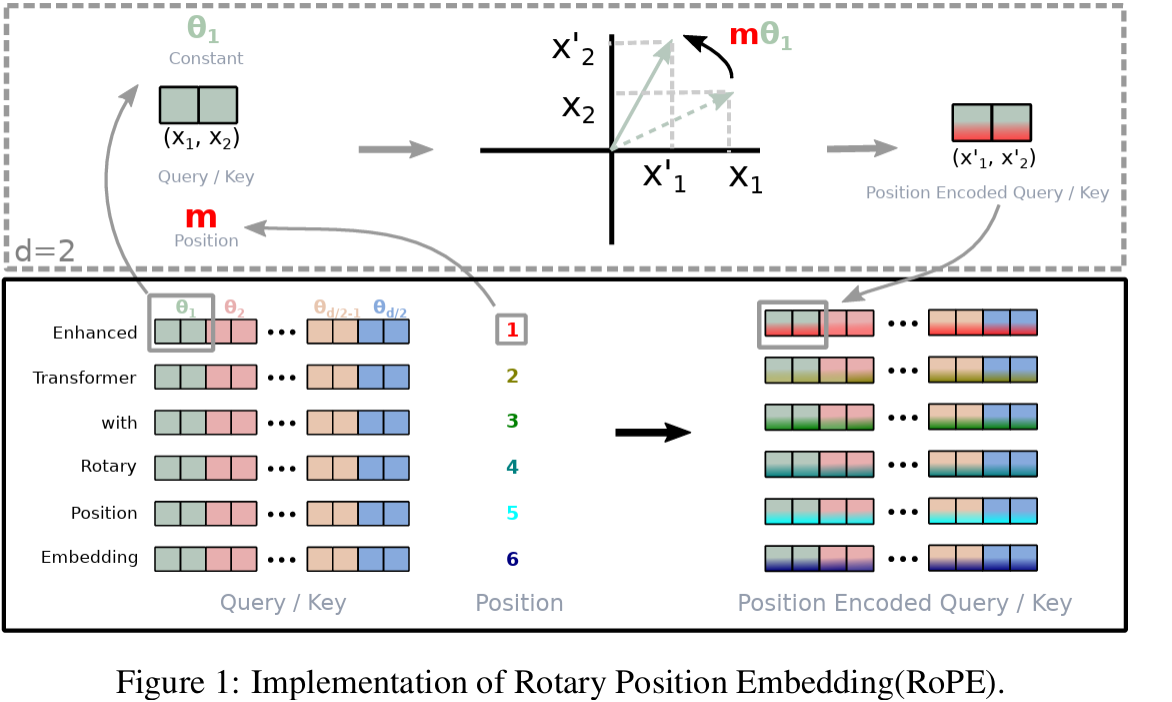-
Positional Encoding is done to account for the fact the order tokens appear in sequence is important
- The original positional encoding proposed encodes both the absolute position of a token, and its position relative to other tokens. For any fixed offset
, the positional encoding at can be obtained through linear projection of at . - An ideal positional encoding has the following properties 1
- Unique encoding for each position across sequences regardless of sequence length.
- Linear relation between two encoded positions (for simplicity).
- Generalizable to longer sequences than those encountered in training.
- Deterministically generated
- Extensible to multiple dimensions.
- The original positional encoding proposed encodes both the absolute position of a token, and its position relative to other tokens. For any fixed offset
-
Position encoding can either be applied to only the first input, or in every layer. The latter tends to be more performance.
-
The positional encoding
is applied to as follows -
Sinusoidal Positional Embedding constructs the embedding as follows
-
Learned Positional Encoding involves treating
-
Rotary Position Embedding (RoPE) 2 encodes the absolute position with a rotation matrix while incorporating explicit relative position dependency.
-
We formulate the inner product of
-
Consider the simpler case of
Further assume we have the initial conditions with no position information encoded.
We use Complex numbers to represent the
Where
We can find a solution by setting
One solution could therefore be to set
Furthermore, since
For some function
Also setting
Thus
Let us set
Therefore
Where
-
We can represent the solution using a rotation matrix of the form
-
In the general form where
Where
And
The inner product is therefore
-
For completeness, set
-
Because
-
Notice we do not add position information to the values.
-
One main challenge with RoPE is extrapolation.
-

-
3 proposes a modified relative positional encoding for use in models that have extended context lengths.
We use the following decomposition. Let
We perform the following reparameterization
- Replace
𝕕 - Replace
- Since the query vector is the same for all query positions, the bias should remain the same regardless of query positions.
- Split
- The final reparameterization now looks like
- The first term corresponds to content-based addressing
- The second term corresponds to content-dependent positional bias.
- The third term corresponds to global content bias
- The fourth term correspond to global positional bias
- Replace
- 4 introduces relative positional encoding.
- Rationale: This is one approach to consider arbitrary pairwise relations between any two input tokens. We treat the input as a labeled fully connected digraph.
- The edge between input elements
- We clip the maximum distance to a maximum absolute value
-
Rationale: This lets us generalize to sequence lengths not seen in training. Also it is hypothesized that previse positional information is not useful beyond a certain distance.
-
We consider
Where
-
For efficiency, we share the relative position encoding either across heads or across sequences
-
- When computing the scaled dot product, we separate the computation and perform tensor reshaping on the second term in the following
The computation for the output using
Incorporating Long Contexts
- Attention with Linear Biases (ALiBi) 5 proposes a position encoding method where we add a bias for query-key attention scores with a penalty proportional to their distance.
-
The authors speculate that the failure to extrapolate is due to the choice of positional encoding used.
-
Using ALiBi entails training the model on short sequences. Thus, training incurs lower cost.
-
ALiBi simply entails modifying the attention mechanism by introducing a static, non-learned bias. For the
Where
- The paper uses a geometric sequence for
- The paper uses a geometric sequence for
-
ALiBi has an inductive bias towards recency. The penalty decreases as the distance between a key and query diminishes.
-
ALiBi’s decrease in perplexity when given longer sequences is largely explained by its improved avoidance of the early token curse
-
Limitation: When using a larger context during validation, ALiBi might not actually be using contexts longer than the one it was trained on.
-
- 6 propose the DA-Transformer (distance aware transformer) which incorporates the real distance between tokens in re-scaling raw self-attention weights.
- Rationale: Global and local context modelling usually have different distance preferences for attention.
- In each attention head, we use a learnable parameter
- We then design a function
- The scale of
- Our choice for
- The re-scaled coefficients are used to adjust the attention weights. We obtain the attention matrix as follows
- The scaling is multiplicative since adding might over-amplify the attention weights.
- The ReLU is incorporated since the sign of
- ReLU also adds sparsity since only positive attention is amplified.
- The extra time and space complexity for computing the above is
Links
-
Zhang et. al Ch. 11 - for everything about the basics of the transformer model.
-
All about Attention - more about attention
Footnotes
-
RoPE has all these properties. See https://huggingface.co/blog/designing-positional-encoding ↩
-
Su et al. (2021) RoFormer: Enhanced Transformer with Rotary Position Embedding ↩
-
: Dai et al. (2019) Transformer-XL: Attentive Language Models Beyond a Fixed-Length Context ↩
-
Shaw, Uszkoreit, Vaswani (2018) Self-Attention with Relative Position Representations ↩
-
Press, Smith, Lewis (2021) Train Short, Test Long: Attention with Linear Biases Enables Input Length Extrapolation ↩
-
Wu, Wu, Huang (2021) DA-transformer: Distance Aware Transformer ↩